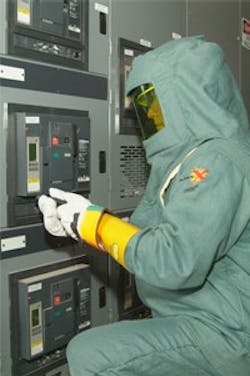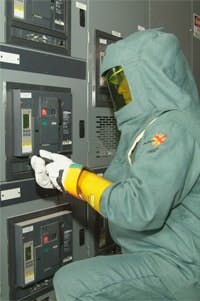In brief:
- Electrical hazards are a significant safety and financial risk for electrical workers and their employers.
- While the threat of shock and electrocution from inadvertent contact with energized parts has long been recognized, the arc flash and arc blast hazards have only fairly recently been incorporated into the electrical safety standards.
- The National Fire Protection Association's (NFPA) standard 70E 2009 provides a detailed reference for facilities to meet the requirements of electrical workplace safety.
Five to 10 times per day in the United States, a worker is severely injured or killed in an electrical arc flash accident. Other electrical incidents can also injure workers; these typically involve accidental contacts with energized parts that result in shock and electrocution. The injuries and fatalities that result from these accidents are always devastating to the workers and their families. Additionally, the financial consequences of such events can be very damaging to the employer.
There are important steps that companies can take to reduce the occurrence of electrical accidents and better protect the worker and the employer from the physical, financial and statutory consequences of electrical accidents. Following are the required steps for reducing the risk of electrical accidents. Many of these steps are required as part of the National Fire Protection Association (NFPA), in its standard 70E 2009, which provides a detailed reference for facilities to meet the requirements of electrical workplace safety. Additional steps are recommended and considered best practices for improving overall safety within a facility.
Clearly, the fundamental requirement for electrical safety is always to place electrical equipment in an electrically safe condition whenever possible through a proper lock out/tag out procedure. But NFPA 70E 2009 provides additional best practices for electrical safety, and these are recognized and enforced by OSHA.
Establish an electrical safety program with clearly defined responsibilities. This is a written document created by the employer that covers all areas of the company’s electrical safety policies and includes such things as lock out/tag out procedures, internal safety policies, and responsibilities for electrical safety.
Figure 1. The incident energy potential will define the hazard/risk category of personal protective equipment that an employee is required to wear.
Conduct an electrical system study to determine the degree of arc flash hazard. This is an electrical system engineering study that is performed by engineers familiar with the power distribution and control equipment and the calculation methods required. The arc flash analysis will determine, among other things, the incident energy potential of each piece of electrical distribution equipment in the facility. This incident energy potential will define the hazard/risk category of personal protective equipment (PPE) that the employee is required to wear while performing any work when energized parts are exposed (Figure 1). The methodology for conducting these arc flash analyses is outlined in IEEE 1584 Guide for Performing Arc-Flash Hazard Calculations.
One alternative to a detailed arc flash analysis that is permitted in NFPA 70E 2009, Article 130.3 Exception Number 2, is to use the task tables in 130.7(C)(9) to determine the required PPE hazard risk category. The tables have usage limitations as stated in the footnotes. The footnotes typically specify a range of available fault current and clearing time for the upstream over-current protective device beyond which the tables may not be safely used. Unless a detailed arc flash analysis has been performed, users will usually not know these details, and this commonly leads to misuse of the task tables, which can lead to under protection for the worker.
The task tables are based on some calculated values within the limits of the stated footnotes but also include the probability of causing an arc flash based on the task being performed. This probability factor is highly variable and subjective, and can potentially lead to significant under protection. Since NFPA 70E 2009, Article 130.3(C), now requires the equipment be labeled with either the incident energy in calories per square centimeter or the PPE hazard risk category, using the tables creates a problem with labeling, as well. Relying on a detailed arc flash analysis for PPE selection is always a preferred and more accurate method.
Conduct safety training for all workers. NFPA 70E defines a qualified person as “one who has skills and knowledge related to the construction and operation of the electrical equipment and systems, and has received safety training to recognize and avoid the hazards involved.” This training requirement means that the employee must have received safety training specific to the hazards of arc flash, arc blast, shock, and electrocution. Electrical workers are not considered to be qualified by OSHA until they have received this specific training.
Ensure there is adequate personal protective clothing and equipment on hand. Employees working in areas where there are potential electrical hazards shall be provided with electrical protective equipment that is appropriate for the specific parts of the body to be protected and for the work to be performed. This can include fire-resistant shirt, pants or coveralls, or a multi-layer flash suit.
Ensure the proper tools are on hand for safe electrical work. In addition to PPE, the standards require the employer to furnish other tools for safe electrical work. This includes insulated voltage-rated hand tools and insulated voltage-sensing devices that are properly rated for the voltage application of the equipment to be tested.
Apply warning labels to all equipment. Currently, NFPA 70, dated 2011 (National Electric Code), states in Article 110.16: “Flash Protection. Electrical equipment, such as switchboards, panelboards, industrial control panels, meter socket enclosures, and motor control centers that are in other than dwelling occupancies and are likely to require examination, adjustment, servicing, or maintenance while energized shall be field marked to warn qualified persons of potential electric arc flash hazards. The marking shall be located so as to be clearly visible to qualified persons before examination, adjustment, servicing, or maintenance of the equipment.”
[pullquote]The current NEC requirement for application of hazard warning labels on electrical equipment, the National Electrical Code (NEC) 2011, doesn’t require that the specific information, such as the PPE hazard/risk category, incident energy, boundary distances, and other data that would be provided by the arc flash hazard analysis, must be included on the label. However, the current NFPA 70E 2009, in Article 130.3(C). has elevated the labeling requirement by stating, “Equipment shall be field marked with a label containing either the incident energy or required level of PPE.”
Best practices
Appoint an electrical safety program manager. Identify a safety professional from your organization who has vast knowledge and experience within the electrical industry. This should be a well-organized, responsible individual who will take the position seriously. Having a single individual who is familiar with electrical code requirements and other safety issues will pay off.
Figure 2. Electrical distribution systems contain active components such as circuit breakers that help protect the system in the event an electrical fault occurs.
Maintain all electrical distribution system components. All electrical distribution systems contain active components such as fuses, circuit breakers, and protective relays that help protect the system in the event an electrical fault occurs (Figure 2). These components, called over-current protective devices, have a critical role in protecting the system, but are also crucial when it comes to protecting workers from the hazards of arc flash and arc blast. Modern, properly adjusted over-current protective devices that have been well maintained are able to detect an arcing condition almost instantaneously and clear the fault quickly. This always results in significantly reducing the amount of incident energy that is released.
Many existing electrical distribution systems have old components that have not been well maintained over long periods of time. In actual field testing of these devices, it is often apparent that their ability to react to an arcing event is much slower than would be the case with a modern, well-maintained device. Unless the protective device optimally reduces the time to clear the fault, the hazard to a worker standing within the flash protection boundary can dramatically increase. In the past, attention to maintenance and condition of these devices in many facilities has not been a primary concern for most facility owners, as in many cases it was not clearly understood that poor condition or inadequate maintenance of the devices presents an elevated safety hazard for workers.
With the current focus on workplace hazards and electrical safety, companies will be more vigilant when it comes to the condition and maintenance of its electrical system. This requirement for maintenance of electrical distribution equipment has also been incorporated in the NFPA 70E in 2009.
Maintain and update electrical distribution documentation. Electrical distribution system documentation is another important area that has not been well managed in many facilities. Documents such as the electrical one-line diagram (essential to safety when performing the lock out/tag out process), short circuit and coordination studies, and other critical documents often are not well maintained. When system components change due to revisions or facility expansions, this documentation is often not updated to reflect these changes. Lack of attention to documentation management makes the cost and work scope of providing accurate arc flash hazard analysis much greater. Since these documents are such a critical part of electrical safe work practices, lack of attention creates additional legal liability if an accident does occur.
Electrical hazards are a significant safety and financial risk for electrical workers and their employers. While the threat of shock and electrocution from inadvertent contact with energized parts has long been recognized, the arc flash and arc blast hazards have only fairly recently been incorporated into the electrical safety standards. The recent focus on and awareness of arc flash and arc blast hazards will play a critical role in reducing the incidence and severity of electrical accidents over time.
Steven Maling is marketing director, projects & services, at Schneider Electric (www.us.schneider-electric.com). Contact him at [email protected].


